
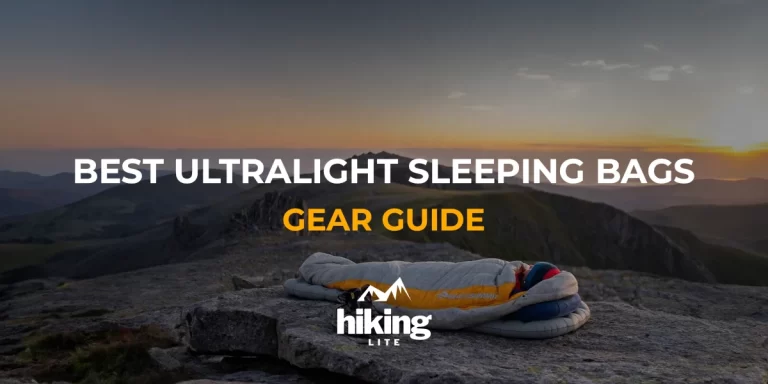
As warmer weather arrives, it’s time to ditch that heavy winter bag for one of the best ultralight sleeping bags designed for spring, summer and fall trips.
But with so many options on the market, how do you choose the bag that’s just right for your needs and upcoming adventures?
In this guide, we’ll break down the top 5 best ultralight sleeping bags rated for three-season use. Whether you’re an hardcore backpacker shaving ounces or a casual camper, weight and temperature rating should be your top priorities.
Let’s get started.
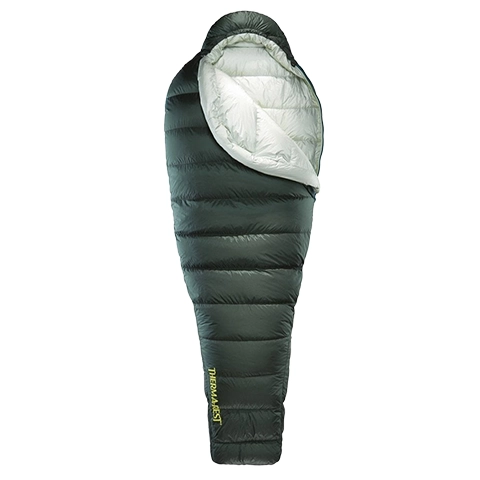
Key Specs
Weight: 1lb 0.2 ounces (462 grams)
Limit Temp Rating: 32ºF | 0ºC
Price: $$$
PROS
✅ Packs small
✅ Hydrophobic down
CONS
❌ Temperature rating is bit optimistic
The Hyperion 32F is an impressively lightweight bag that marries design and performance. Its efficient construction and premium down insulation allow it to punch above its weight class in terms of warmth.
However, my testing found it runs slightly cooler than advertised – more like 35F comfort levels on colder nights. While toasty on my back, I encountered cold spots along the two-way zipper when sleeping on my side or stomach.
The draft tube placement atop the zipper didn’t seem effective at preventing leaks either. A less vertical baffle layout and better constructed zip might solve this. Overall warmth and comfort really depend on sleeping flat on your back.
The Hyperion is a great ultralight bag, but it may not suit colder or side sleepers due to its design. Yet, its weight is unbeatable.
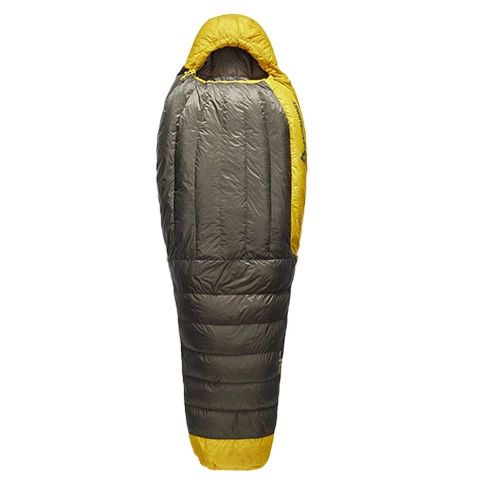
Key Specs
Weight: 1lb 1.6 ounces (498 grams)
Limit Temp Rating: 30ºF | -1ºC
Price: $$$
PROS
✅ Relatively expensive
✅ Hydrophobic down
CONS
❌ None
The Spark from Sea to Summit is an excellent choice for lightweight backpacking. Weighing just over 1lb for the regular size, it offers exceptional warmth-to-weight ratio thanks to its stellar 850+ fill power goose down insulation.
This bag kept me warm down to freezing temperatures with its mummy fit design, maximizing heat retention. The breathable 10D nylon fabric ensures proper ventilation to prevent overheating, while the hydrophobic down treatment sheds moisture well in damper conditions.
Comfort features such as a deep-fitting technical hood, generous footbox, and double draft collars enhance functional warmth. The 3/4 zipper allows for easy ventilation as needed, and the bag packs down impressively small for its quality insulation.
Compared to previous Spark models, Sea to Summit has addressed issues with zipper snags catching, resulting in smooth and unrestricted entry/exit.
While pricey, it’s easy to see why – you really do get what you pay for with the best down insulation and build quality. For cold-weather minimalists, the Spark is worth the investment to ensure unbeatable warmth-to-weight ratio and years of reliable use.
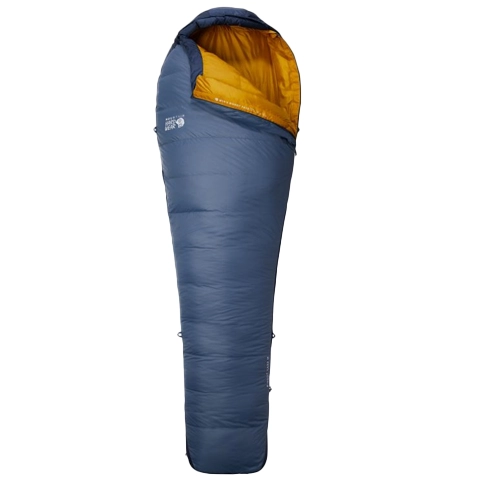
Key Specs
Weight: 1lb 12.6 ounces (810 grams)
Limit Temp Rating: 30ºF | -1ºC
Price: $$
PROS
✅ Good quality
✅ Packs small
CONS
❌ Temperature rating is bit optimistic
The Bishop Pass delivers versatile warmth and performance for varied outdoor activities. Featuring 650 fill power down insulation, it maintains an excellent warmth-to-weight ratio for alpine starts and multi-day adventures.
Subtle details like a contoured footbox and down-filled face gasket enhance comfort. Full-length draft tubes and a roomy hood prevent heat loss. Internal stash pockets and stuff sacks for compact storage are welcomed additions.
Construction quality is top-notch with a durable #5 YKK zipper and breathable fabrics. I appreciate the form-fitting mummy shape and generous toe box.
However, while marketed as a 30 degree bag, I found it ran colder – only comfortable to around 38 degrees in real-world testing. Additional baffles in the neck may help, but warmer sleepers likely need a lower-rated option.
Overall, the Bishop Pass is a well-designed bag for shaving ounces. Just be aware of its temperature limitations for solo trips in truly cold conditions. Western Mountaineering’s quality is evident throughout.
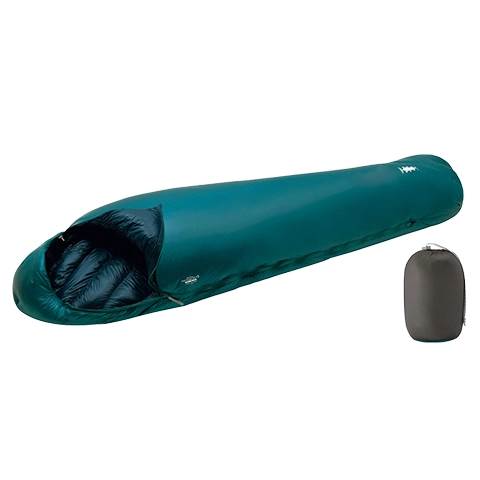
Key Specs
Weight: 1lb 2.7 ounces (531 grams)
Limit Temp Rating: 30°F | -1°C
Price: $$$
PROS
✅ Durable
✅ Anti-snag zipper
✅ Good for side sleepers
CONS
❌ If you are >6 feet, get a longer bag
The Montbell bag impressed with innovative features that enhance warmth and usability. The Spider Baffle and Spiral Stretch systems cater well to side sleeping while the insulated zipper prevents drafts – together ensuring the temperature rating is accurate.
The fabric is incredibly soft and cozy like bedsheets. New down distribution allows customized warmth while reducing weight – a brilliant upgrade. With 800 fill power down, it is impressively warm and compressible.
For those under 6 feet, fit will be roomy and comfortable. Side sleepers, lightweight enthusiasts and those needing reliable winter warmth will find much to love.
Montbell clearly designed this for optimized performance. The ability to shift down without sacrificing warmth is a huge plus.
After testing, I can confirm the temperature claims held true as promised. An excellent bag for three-season use or cold-weather trips seeking quality construction and innovative comfort.
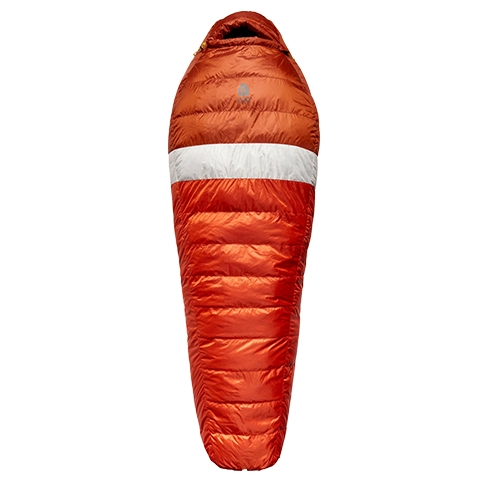
Key Specs
Weight: 1lb 12 ounces (770 grams)
Limit Temp Rating: 26°F | -3°C
Price: $
PROS
✅ Very warm
✅ Relatively affordable
CONS
❌ Relatively heavy
❌ Temperature rating is bit optimistic
The Get Down 35 from Sierra Designs offers warmth and packability on a budget. With a 20D polyester shell and 550-fill DriDown insulation, it proves reliably warm even in changing weather.
Baffled construction prevents cold spots while thoughtful details like interior pockets and a snug hood retain heat. It compresses well for easy packing in any pack.
While a competent 3-season bag, if there is any chance of cooler temperatures, I’d recommend sizing up. My testing found it ran slightly chillier than rated and a warmer bag would have served me better on colder nights.
Overall, the Get Down 35 delivers excellent value for new and experienced campers alike. Just be aware of its limitations in truly cold conditions.
Choosing the right 3-season or 3.5-season sleeping bag takes some consideration. Use this guide to pick a bag that will keep you comfortable for mile after mile.
If you want to find out more about sleeping bag temperature ratings, check out our post here.
If you’re curious about the differences between down and synthetic insulations, you can read our post here.
By evaluating these factors, you’ll find a 3-season bag tailored perfectly to your needs and outdoor adventures.
If you didn’t find the perfect sleeping bag in this guide or you think the temperature rating isn’t warm enough, don’t worry.
You can improve your sleep system’s warmth by using a sleeping bag liner. Check out some of the lightest sleeping bag liners here.
When choosing the best ultralight sleeping bag for hiking, camping, travel and adventure, consider the temperature rating in relation to anticipated conditions, choose down or synthetic filling based on climate, minimize weight through high fill power and tailored designs, add functionality with pockets and draft blocking features, and find the ideal warmth-to-weight ratio by comparing top-rated bags.
Most ultralight sleeping bags for 3-season outdoor use weigh around 1 pound or less, thanks to innovative mummy designs and premium down insulation that can pack down small, while still providing warm comfort down to 30-35 degrees Fahrenheit. Slightly heavier but more versatile options around 1 pound 10 ounces are also suitable for multifaceted trips seeking warmth and value.
When using an ultralight sleeping bag, wear lightweight base layers, bring a sleeping bag liner to add insulation and wick away moisture, wear a neck gaiter to cover exposed areas of the neck and chest, pack a compressible down or synthetic puffy jacket to add warmth if needed, stay hydrated by drinking water before bed to avoid having to get up and let heat out of the bag, choose an insulated sleeping pad with an R-value of at least 3 to isolate the body from the cold ground, and utilize the mummy shape and draft tubes of the bag to conserve heat while sleeping in a curled position.